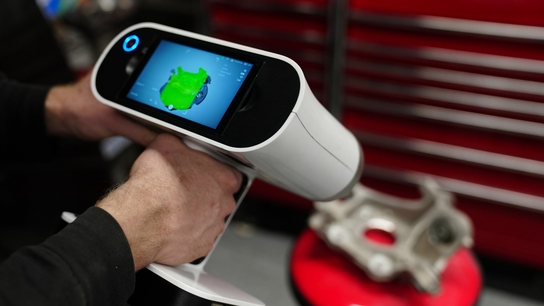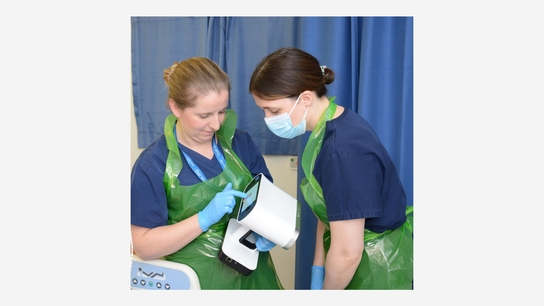Concert hall renovated with unique echo-proof acoustic paneling using Artec Leo
Challenge: Rapidly replacing unfit for purpose fabric-clad acoustic panels at Ningbo Youth Hall with enhanced, made-to-measure aluminum alternatives.
Solutions: Artec Leo, Artec Studio, Geomagic Design X
Result: With Artec Leo, engineers captured the hall’s existing panels in high detail, in the space of just four hours. These scans yielded a parametric model – this served as an ideal basis for designing echo-masking upgrades.
Why Artec 3D? Wireless & target-free, Artec Leo made capture as simple as ‘point and shoot.’ Its 35 mln pt/s scan speed and built-in screen allowed for complete, high-speed data collection. Artec Studio then simplified the processing of this data, which could be exported to Design X in a single click.

An engineer using Artec Leo to capture the surfaces of acoustic panels
As their name suggests, concert halls are places where people can go and enjoy live musical performances. Many of these feature exquisite architecture and a unique style, making them works of art in their own right. They also tend to be deeply rooted in their host cities, where they nourish cultural spaces with music, and become important cultural landmarks.
If you have ever been to a concert hall, you may have noticed that its walls are very different to those of an ordinary building. Concert hall interiors often have uneven surfaces and are densely packed with honeycomb-like holes.
They’re shaped like this to ensure they meet a number of stringent acoustic criteria. Among these, achieving a uniform sound field distribution without echo interference is paramount. With this in mind, the concave and convex walls of concert halls are adorned with acoustic panels – specialized decorative devices used to regulate indoor sound reflection and absorption.
Each is densely distributed with holes to absorb sound. These small holes reduce the reflection of soundwaves, while uneven panel surfaces have a scattering effect, causing waves to intersect and dissipate. All this interference means that soundwaves fail to reach the energy level required for echoing.
By ensuring that echo interference is controlled, acoustic panels essentially deliver an improved listening experience to audience members. However, they may now be ubiquitous in halls and theaters, but their non-standard dimensions and extensive coverage make obtaining precise measurements and finding off-the-shelf maintenance spares extremely tricky.
Renovating Ningbo Youth Hall
Ningbo Youth Hall was recently made home to a new concert hall. However, after its completion, the facility’s management expressed concerns about the construction of its walls, believing there was room for improvement.

The concert hall pre-overhaul (with walls marked red for renovation)
The area between the surface of the hall’s acoustic paneling and its walls was initially covered with translucent cloth. Lined with plastic, each panel was filled with decorative lighting strips, to guide audience members to their seats. But it turned out that the fabric didn’t meet overall design requirements.
It was also discovered that translucent cloth is not very easy to maintain, while lighting strips proved susceptible to attracting insects like mosquitoes and flies. As such, after much consideration, it was decided that this cladding would be replaced with an LED-lighting equipped aluminum alternative.
Sizing panels with Artec Leo
When it came to measuring the concert hall’s walls, the engineers behind its revamp encountered a problem. Not only did they measure a total of over 100 meters, each part was bumpy, irregularly shaped, and almost impossible to measure accurately with traditional methods.

Before renovating, translucent cloth cladding and plastic sheathing was used between the concert hall’s walls (pictured)
To tackle this, Ningbo Youth Hall decided to acquire a market-leading dimensional measurement and reverse engineering solution. Soon after, they contacted Artec 3D Gold Certified Partner Ningbo FLD-TECH Co., Ltd, whose experienced team of engineers recommended acquiring the Artec Leo 3D scanner.
Capable of capturing data at up to 35 million points per second with 0.1mm accuracy, Artec Leo delivers astonishingly precise 3D models at pace. Its HD touch screen allows for real-time feedback while its wireless, click-to-scan functionality makes it ‘point and shoot,’ just like a smartphone.
After scaffolding had been erected on-site, Leo was able to capture acoustic paneling across the entire hall in just four hours. The device’s built-in display was pivotal to achieving this, allowing engineers to check for missing data on the move, while its all-in-one design also freed them of cumbersome cables.
“We put some blue tape on the wall as a reference for 3D scanning,” said Guodong Xiao, President of Ningbo FLD-TECH. “Combined with Artec Leo’s wide field of view, the tracking was very stable throughout the scanning process. The final 3D data stitching was also fantastic.”
From 3D scan to customizable CAD
Despite Leo capturing more than 100 GB of raw data, Artec Studio made quick work of aligning, registering, and fusing this into a complete 3D mesh.
Moving the highly detailed results to the Geomagic Design X industry-leading reverse engineering software also proved seamless. After importing their data from Artec Studio in a single click, Ningbo FLD-TECH engineers found they had all the tools needed to convert scan data into solid, editable CAD models.

The engineers’ parametric model on Geomagic Design X
It was this parametric design that served as the perfect basis for the 2D drawings needed to create custom aluminum panels. In order to establish the viability of their reverse engineering project, the FLD-TECH team initially imported the 2D drawings into a laser cutting machine.
From there, they made a sample panel from wood and brought this to the project site for testing. Ultimately, their 3D scanning and reverse engineering combination proved a formidable one that successfully yielded a precisely fitted panel surface, which met the customer’s exact requirements.
3D scanning for high-end interiors
Wherever you look, from room decoration to complete property renovation, interior design continues to grow in popularity among homeowners around the world. In tandem, 3D scanning is increasingly being used to digitize interiors, so aspiring decorators can see how their ideas will play out in real life.
While results depend heavily on designer skill level, there’s no doubting that advanced technologies are becoming a powerful idea visualization tool. For Xiao, Leo’s balance of powerful performance and wireless usability make it perfect for this role, and he sees it having a bright future in interior design.

The new concert hall with custom aluminum panels
“Leo is unique in its ability to balance accuracy and speed when collecting data from large indoor areas with high efficiency, and it has a wide range of applications in interior decoration,” added Xiao. “We have also used Leo to design the staircase of a villa. It’s great!”
Those interested in finding out more about 3D scanning for interior design can find a full guide on how to 3D scan a room here.
Scanners behind the story
Try out the world's leading handheld 3D scanners.




